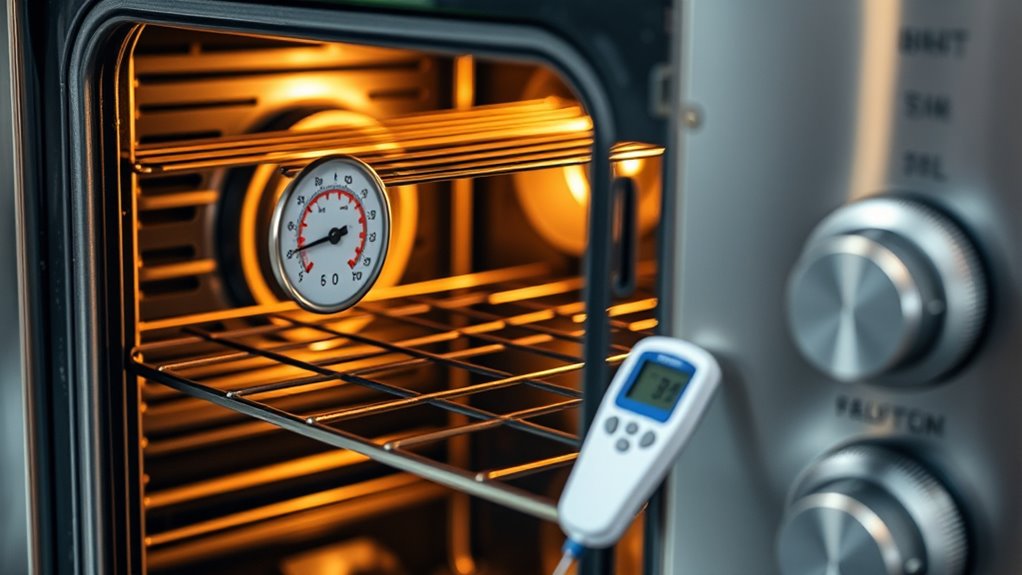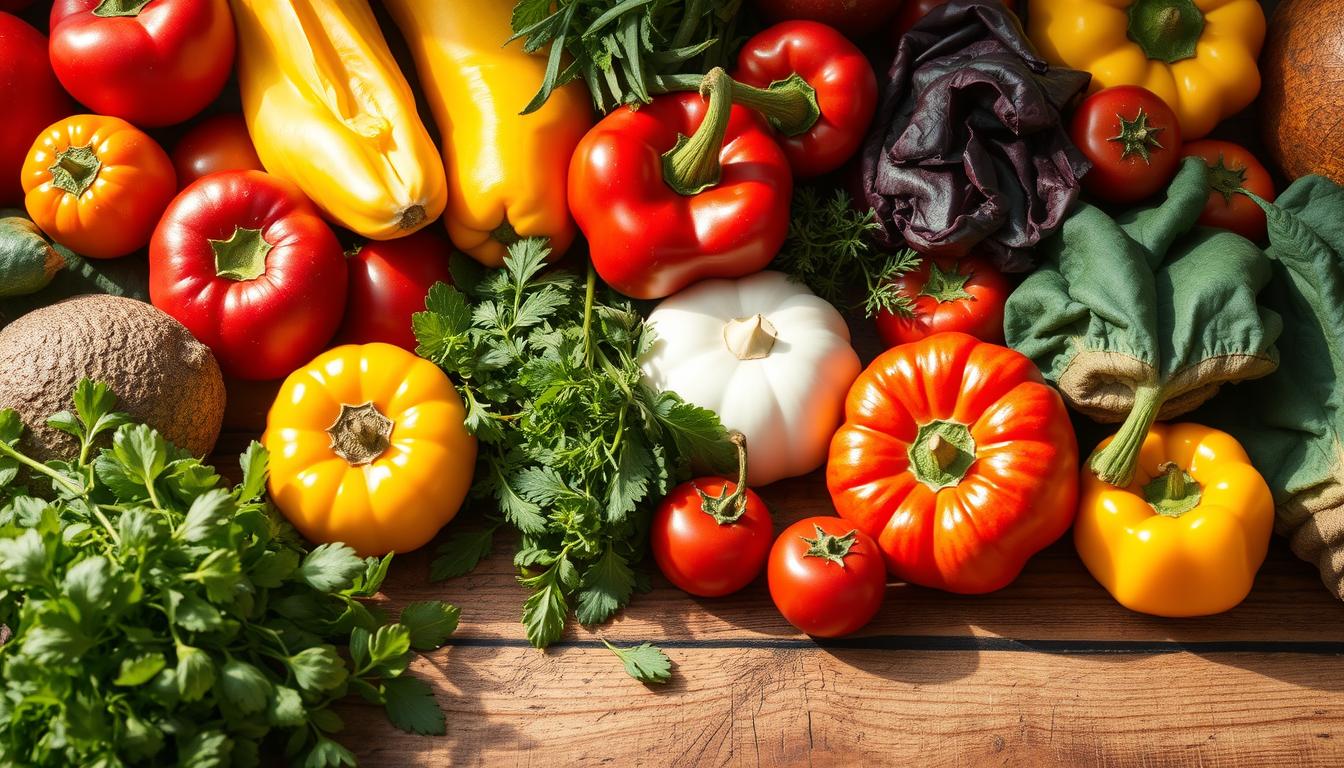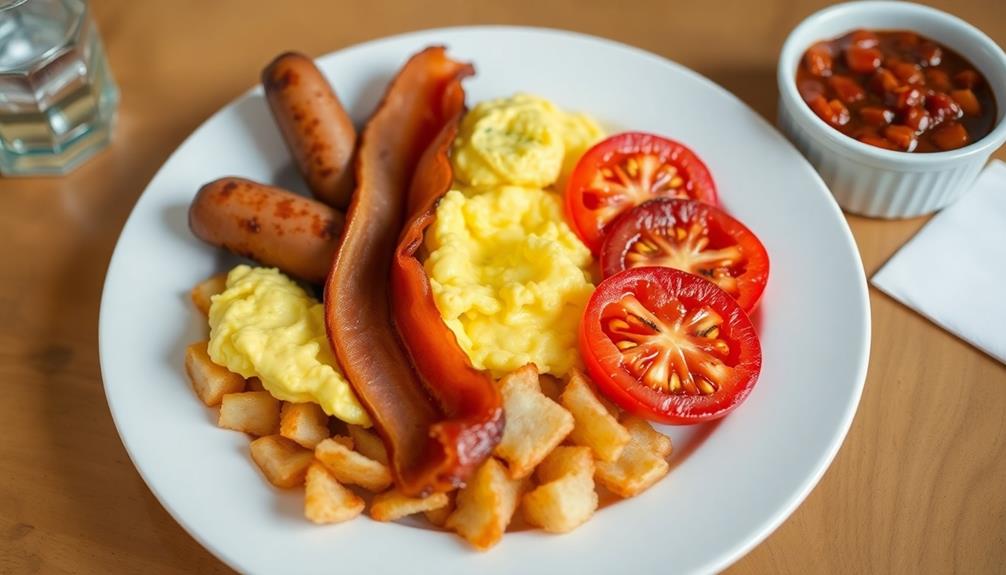To calibrate your oven for precision baking, start by placing a reliable oven thermometer in the center and preheat to your usual baking temperature. Compare the thermometer’s reading with the oven’s dial. If they don’t match, adjust the oven’s temperature setting if it has a calibration feature or compensate manually by setting slightly higher or lower. Regular checks and adjustments keep your oven accurate—keep going to discover more tips for perfect results.
Key Takeaways
- Place a reliable oven thermometer in the center of the oven and preheat to the desired temperature.
- Compare the thermometer reading with the oven dial to identify discrepancies.
- Adjust the oven’s temperature setting or calibration feature to correct for any difference.
- For manual adjustments, add or subtract heat in small increments and recheck the temperature.
- Recalibrate periodically, especially in older or heavily used ovens, to maintain baking accuracy.

Have you ever noticed that your baked goods come out uneven or take longer than expected? The culprit is often an inaccurate oven temperature, which can throw off your entire baking process. To fix this, you need to calibrate your oven properly, and that starts with understanding how your oven’s temperature aligns with the actual heat inside. The first step is to use reliable calibration tools—such as an oven thermometer—to get precise readings. These tools are affordable and easy to use; simply place the thermometer in the center of the oven, turn it on, and let it heat to your desired temperature. Once the oven reaches that point, compare the temperature reading on the thermometer with what your oven’s dial indicates. If there’s a discrepancy, you’ll need to adjust your oven’s temperature settings accordingly.
Many modern ovens have a calibration function built into their control panels, allowing you to fine-tune the temperature directly. If your oven doesn’t have this feature, you can make manual adjustments by adding or subtracting heat in small increments. For example, if your oven thermometer shows the oven is 10 degrees hotter than the dial indicates, set the oven to a slightly lower temperature to compensate. This calibration process ensures your oven heats more precisely, which means your baked goods will turn out consistently every time. Keep in mind that oven temperatures can drift over time, especially if the appliance is older or frequently used, so it’s a good idea to check and recalibrate periodically. Oven calibration is an important step in maintaining accurate heat levels and ensuring optimal baking results. Regularly checking your oven’s temperature accuracy can also help prevent uneven baking and improve your confidence in the results. Additionally, understanding the causes of temperature inaccuracy can help you troubleshoot and prevent future issues more effectively.
Using calibration tools not only helps you identify temperature inconsistencies but also gives you confidence in your baking. Accurate oven temperatures produce better rise, even cooking, and ideal browning. Additionally, understanding temperature accuracy helps you better control your baking environment for optimal results. Remember, an oven that’s off by just a few degrees can make a significant difference in your results. Once you’ve calibrated your oven, make a note of the adjustments needed—either in your oven’s manual or in a dedicated notebook—so you can repeat the process easily in the future. Proper calibration can also extend the lifespan of your oven and maintain its efficiency over time. Regular calibration with proper tools ensures your oven maintains its accuracy, saving you time and ingredients while elevating your baking game. With a little effort upfront, you’ll enjoy more predictable, perfect baked goods every time, turning your kitchen into a professional-grade bakery.
Frequently Asked Questions
How Often Should I Recalibrate My Oven?
You should recalibrate your oven whenever you notice uneven baking or inconsistent oven temperature. Regular calibration helps maintain baking accuracy, ensuring your baked goods turn out perfect every time. If your oven is new or after moving it, check its temperature with an oven thermometer. Generally, recalibrate every 6 to 12 months or if your recipes start to look off. Staying on top of calibration keeps your baking precise and delicious.
Can I Calibrate a Digital and Analog Oven the Same Way?
Think of calibrating your oven like tuning a musical instrument—you’ll need to approach digital and analog models a bit differently. While the basic process is similar, calibration differences lie in how you access controls: digital ovens often have precise digital settings, whereas analog ovens might require manual adjustments. You can calibrate both using the same principles, but expect some variations in steps to account for their distinct control systems.
What Tools Are Necessary for Precise Calibration?
To calibrate your oven precisely, you’ll need a reliable thermometer to check temperature accuracy and calibration weights if your oven has a digital display that can be adjusted. The thermometer guarantees you measure the oven’s actual temperature, and calibration weights help fine-tune the settings. Make sure your thermometer is accurate and calibration weights are appropriate for your oven type to achieve the best results.
Will Calibrating Affect My Oven’S Warranty?
You’re curious whether calibrating your oven affects warranty coverage. It’s a valid concern because adjusting the oven for temperature accuracy might seem risky. Rest assured, most manufacturers don’t void your warranty for calibration, but it’s best to check your specific model’s policy. Proper calibration helps maintain oven temperature accuracy, ensuring consistent baking results. Keep in mind, if you encounter issues, professional calibration or repairs won’t typically void your warranty.
How Do I Know if My Oven Needs Recalibration?
You’ll know your oven needs recalibration if your baked goods consistently turn out uneven or if the oven temperature seems off compared to your thermometer. Check calibration accuracy by placing an oven thermometer inside and setting your oven to a specific temperature. If the thermometer doesn’t match the oven’s display, it’s time to readjust. Regularly testing ensures your oven maintains accurate temperature control for perfect baking results.
Conclusion
Calibrating your oven guarantees perfect baked goods every time. Did you know that ovens can be off by as much as 20 degrees Fahrenheit? That small difference can change your recipes, making cookies too crispy or bread undercooked. Regular calibration keeps your oven accurate, saving you time and ingredients. Take a few minutes to check and adjust your oven’s temperature—your baking results will thank you, and you’ll enjoy consistently delicious creations every time.










